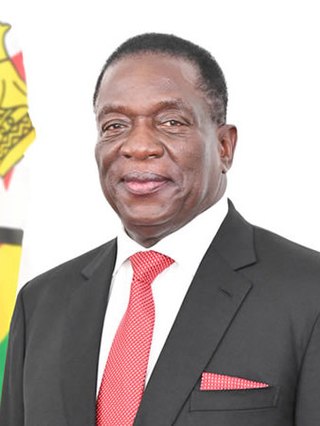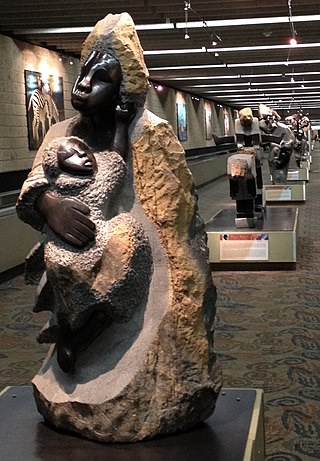Related Research Articles

Zimbabwe, officially the Republic of Zimbabwe, is a landlocked country in Southern Africa, between the Zambezi and Limpopo Rivers, bordered by South Africa to the south, Botswana to the south-west, Zambia to the north, and Mozambique to the east. The capital and largest city is Harare, and the second largest is Bulawayo. A country of roughly 15 million people, Zimbabwe's largest ethnic group are the Shona, who make up 82% of the population, followed by the Northern Ndebele and other smaller minorities. Zimbabwe has 16 official languages, with English, Shona, and Ndebele the most common.

The Gukurahundi was a genocide in Zimbabwe which arose in 1982 until the Unity Accord in 1987. It derives from a Shona-language term which loosely translates to "the early rain which washes away the chaff before the spring rains".

The Zimbabwe African National Union – Patriotic Front (ZANU–PF) is a political organisation which has been the ruling party of Zimbabwe since independence in 1980. The party was led for many years under Robert Mugabe, first as prime minister with the Zimbabwe African National Union (ZANU) and then as president from 1987 after the merger with the Zimbabwe African People's Union (ZAPU) and retaining the name ZANU–PF, until 2017, when he was removed as leader.

Joshua Mqabuko Nyongolo Nkomo was a Zimbabwean revolutionary and Matabeleland politician who served as Vice-President of Zimbabwe from 1990 until his death in 1999. He founded and led the Zimbabwe African People's Union (ZAPU) from 1961 until it merged in 1987 with Robert Mugabe's Zimbabwe African National Union (ZANU) to form ZANU–PF after an internal military crackdown that claimed more than 20,000 of ZAPU supporters.

The Rhodesian Bush War, also called the Second Chimurenga as well as the Zimbabwe War of Independence, was a civil conflict from July 1964 to December 1979 in the unrecognised country of Rhodesia.

Emmerson Dambudzo Mnangagwa is a Zimbabwean politician who has served as President of Zimbabwe since 24 November 2017. A member of ZANU–PF and a longtime ally of former President Robert Mugabe, he held a series of cabinet portfolios and was Mugabe's Vice-President until November 2017, when he was dismissed before coming to power in a coup d'état. He secured his first full term as president in the disputed 2018 general election.
Nicholas Mukomberanwa was a Zimbabwean sculptor and art teacher. He was among the most famous protégés of the Workshop School at the National Gallery of Zimbabwe. He was a mentor to the Mukomberanwa Family of sculptors. Mukomberanwa married his first wife, sculptor Grace, in 1965 and they had eight children. In 1965, he decided to end his career with the police to become a sculptor full-time. He continued to hone his skills over the following decade, developing one of the most distinctive personal styles found in his generation of Zimbabwean stone sculptors. The gambit paid off, and by the late 1970s and in the 1980s his work was being shown in many venues. His work has been exhibited in galleries around the world. He also became mentor to many artists in Zimbabwe, including his children Anderson Mukomberanwa, Ennica Mukomberanwa, Lawrence Mukomberanwa, Netsai Mukomberanwa, Taguma Mukomberanwa,Tendai Mukomberanwa and nephew, Nesbert Mukomberanwa who are also sculptors. He remains one of Zimbabwe's most famous artists.
Boira Mteki was a Zimbabwean sculptor.

Joram Mariga has been called the “Father of Zimbabwean Sculpture” because of his influence on the local artistic community starting in the 1950s and continuing until his death in 2000. The sculptural movement of which he was part is usually referred to as “Shona sculpture”, although some of its recognised members are not ethnically Shona.

Henry Munyaradzi, also known as Henry Munyaradzi Mudzengerere, was a Zimbabwean sculptor. The sculptural movement of which he was part is usually referred to as "Shona sculpture", although some of its recognised members are not ethnically Shona. He worked initially at the Tengenenge Sculpture Community, 150 km north of Harare near Guruve, which he joined in 1967. In that Community, and ultimately in the wider world of lovers of Zimbabwean art, he was known simply as 'Henry'.
Square Chikwanda is a Zimbabwean sculptor, living and working in Harare, Zimbabwe. He first learned his art from his father, also a Zimbabwean sculptor.
Fanizani Akuda, also known as Fanizani Phiri, was a member of the sculptural movement usually called "Shona sculpture", although he and some others of its recognised members were not ethnically Shona. He worked initially at the Tengenenge Sculpture Community, 150 km north of Harare near Guruve, which he joined in 1966.

Robert Gabriel Mugabe was a Zimbabwean revolutionary and politician who served as Prime Minister of Zimbabwe from 1980 to 1987 and then as President from 1987 to 2017. He served as Leader of the Zimbabwe African National Union (ZANU) from 1975 to 1980 and led its successor political party, the ZANU – Patriotic Front (ZANU–PF), from 1980 to 2017. Ideologically an African nationalist, during the 1970s and 1980s he identified as a Marxist–Leninist, and as a socialist after the 1990s.

Sculpture and in particular stone sculpture is an art for which Zimbabwe is well known around the world.
Celia Winter-Irving, was an Australian-born, Zimbabwean-based artist and art critic who wrote extensively on Zimbabwean art, especially Shona sculpture, when she lived in Harare from 1987 to 2008.

Relations between the UK and Zimbabwe have been complex since the latter's independence in 1980. The territory of modern Zimbabwe had been colonised by the British South Africa Company in 1890, with the Pioneer Column raising the Union Jack over Fort Salisbury and formally establishing company, and by extension, British, rule over the territory. In 1920 Rhodesia, as the land had been called by the company in honour of their founder, Cecil Rhodes, was brought under jurisdiction of the Crown as the colony of Southern Rhodesia. Southern Rhodesia over the decades following its establishment would slowly be populated by large numbers of Europeans emigrants who came to form a considerable diaspora, largely consisting of Britons but also smaller groups of Italians, Greeks and Afrikaners. A settler culture that had already existed since the time of company would come to cement fully and the white population began to identify as Rhodesians, often in conjunction with British/Afrikaner/Southern European identities of their ancestors. Southern Rhodesia would go on to participate heavily in both the First and Second wars, providing soldiers and military equipment to the British war effort. During the years after the war, the relationship between Britain and Southern Rhodesia became increasingly strained. The UK had opted to decolonise Africa and had adopted a firm policy of no independence before majority rule, which deeply upset the white establishment of the colony, in particular the radical Rhodesian Front party led by Winston Field and later, Ian Smith. Relations between the British Government and the colonial Southern Rhodesian government deteriorated for much of the early 1960s and negotiations between the two dragged on with little to no success. Eventually, relations broke down entirely and Southern Rhodesia unilaterally declared independence from Britain. The move was met with zero recognition from the international community and the UK government and the illegitimate state was still formally considered under British sovereignty for its roughly 15-year span of existence. For the first 5 years of its proclaimed independence, Rhodesia still declared loyalty to the Queen Elizabeth II as a would-be Commonwealth realm, but this was never recognised by the British monarch who continued to encourage Smith's illegal government to resign. Given her refusal to appoint a Governor-general, from 1965 to 1970 an "Officer Administering the Government" served as the de facto head of state. Rhodesia eventually moved to sever all links with Britain and became a republic with a president in 1970. Throughout the subsequent Rhodesian Bush War between white Rhodesians and black paramilitaries such as ZANU and ZAPU, the UK continued to remain staunchly opposed to the rogue state and extensively sanctioned it, even enforcing blockades using the Royal Navy to cut off Rhodesian oil imports via Portuguese Mozambique. When Rhodesia failed to hold out after 15 years of fighting and came to the negotiating table with the black resistance groups and moderate African nationalist parties, the UK again became directly involved in Rhodesia's affairs. After a brief stint as the nation of Zimbabwe Rhodesia following an Internal Settlement that was denounced by the international community for not being satisfactory enough, the nation transiently reverted to its status as a self-governing British colony before being granted full independence and majority rule as Zimbabwe in 1980 under the landmark Lancaster House Agreement.
State House, formerly known as Government House, is the official residence of the President of Zimbabwe and is located in Harare, Zimbabwe. It was previously used by the Administrator of Southern Rhodesia, Governor of Southern Rhodesia and the Governor-General of the Federation of Rhodesia and Nyasaland in addition to being occupied by the internationally unrecognised Rhodesian Officer Administering the Government and later President of Rhodesia. It was constructed in 1910 to a design by Detmar Blow in the Cape Dutch revival style.
The Statue of Robert Mugabe is a 12-foot-high (3.7 m) springstone statue of the former Zimbabwean president Robert Mugabe located at State House in Harare. Made by the Zimbabwean sculptor Dominic Benhura, it was unveiled in 2016 but was subject to criticism and mockery for its design.
Africa–North Korea relations refers to the diplomatic relations between the Democratic People's Republic of Korea and the continent of Africa. Many African nations maintain a close relationship with North Korea, despite United Nations sanctions on North Korea.

Squatting in Zimbabwe is the settlement of land or buildings without the permission of the owner. Squatting began under colonialism. After Zimbabwe was created in 1980, peasant farmers and squatters disputed the distribution of land. Informal settlements have developed on the periphery of cities such as Chitungwiza and the capital Harare. In 2005, Operation Murambatsvina evicted an estimated 700,000 people.
References
- ↑ "Art gallery – Arts centre - Tengenenge Art Community". www.petitfute.co.uk. Retrieved 2 March 2021.
- ↑ "African carvers teach cultural tradition". Coast Reporter. Retrieved 2 March 2021.
- ↑ Kalilu, R. O. Rom (1994). African Art: Definition, Forms and Styles. Ladoke Akintola University of Technology. p. 96. ISBN 978-978-32736-0-3.
- ↑ "The beauty of Tengenenge Village". The Herald. Retrieved 2 March 2021.
- ↑ "Twitter mocks Mugabe's new statue". The Citizen. 11 September 2016. Retrieved 2 March 2021.